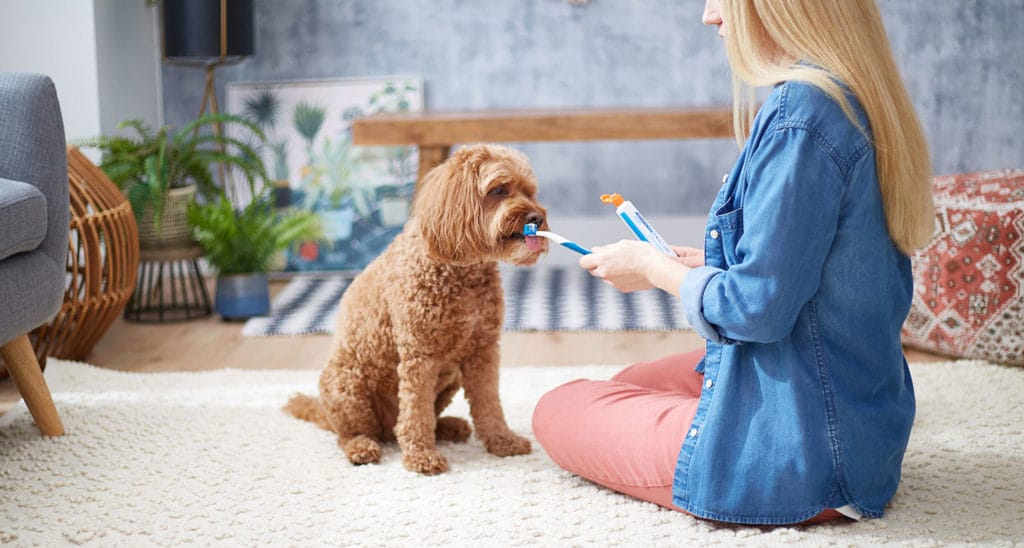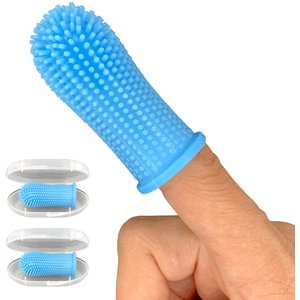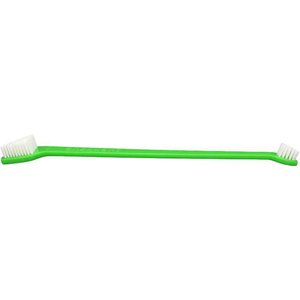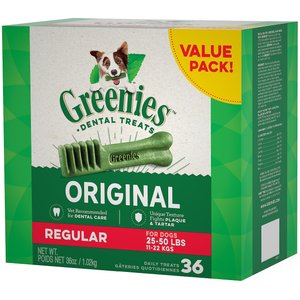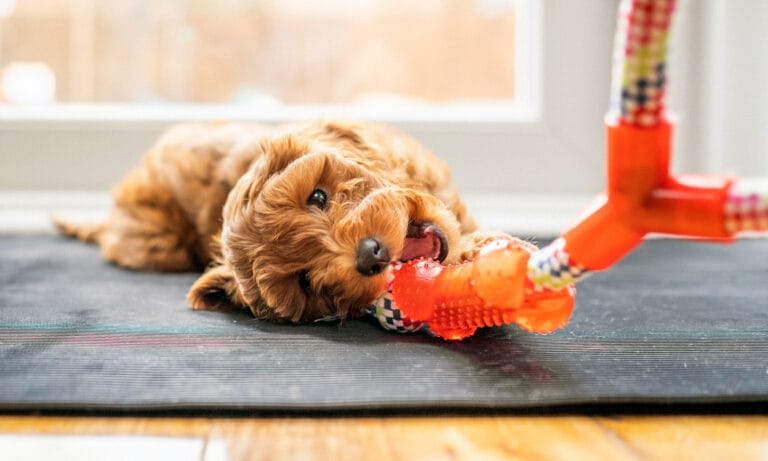Do you put off brushing your dog’s teeth because it turns into a wrestling match? Are you not even entirely sure how to brush your dog’s teeth? This important grooming process is more than just cosmetic—dental disease is the most common preventable disease in dogs.
“Dental care improves health and quality of life by reducing inflammation and infection that leads to systemic problems and eventually pain,” says Bert Gaddis, DVM, DAVDC, owner of Indian Springs Animal Clinic in Pelham, Alabama. “Good health care, including dental care, is associated with our pets living longer.”
Maintaining your dog’s dental health doesn’t have to be a chore. The secret to toothbrushing success is addressing all of the handling that goes along with the brushing process and helping your dog learn to accept it with ease. Read on for a comprehensive lesson on how to brush a dog’s teeth.
In This Guide
What Can I Use to Brush My Dog’s Teeth?
Before we dive into how to clean dogs’ teeth, let’s take a quick look at the tools you’ll need. It’s probably no surprise that they look similar to your own dental health tools—sans the dental floss, of course:
Best Toothbrush for Dogs
Have you ever wondered what to brush a dog’s teeth with? Dog toothbrushes come in a range of styles, including single head, double head and one that fits on the end of your finger.
Experts recommend using a soft-bristled brush to prevent damage to the gum line.
Whether you use a regular dog toothbrush or a fingertip pet toothbrush is up to you, but keep in mind that a large dog might accidentally bite down on the fingertip type of brush. Ouch!
What’s the Best Toothbrush for Puppies?
When searching for the best toothbrush for your puppy, veterinary experts Dr. Sabrina Kong, DVM, Certified Canine Rehabilitation Practitioner at Jules Veterinary Center in Tracy, California, and Dr. Dwight Alleyne, DVM, a practicing veterinarian in Marietta, Georgia, say to make sure it’s appropriately sized for their mouth so it’ll be more comfortable for them.
Want to effectively—and easily—reach all surfaces of your pup’s teeth? Dr. Kong recommends angled or double-headed brushes to do just that. Like for us humans, it’s best to look for soft bristles to prevent gum damage, Dr. Kong says. A good option for puppies is a finger toothbrush since these give more control and are less intimidating compared to regular puppy toothbrushes, Dr. Kong says. Avoid brushes with stiff bristles or a large head since they can be uncomfortable for your pooch.
Whether you want to try a finger toothbrush or a regular puppy toothbrush, Dr. Alleyne suggests looking for one that is made from a soft material, such as silicone or rubber, as opposed to hard plastic.
Dog Toothpaste
Specially formulated for cleaning dogs’ teeth at home, the various brands of dog toothpaste come in savory meat, mint and other lip-smacking, breath-freshening flavors, and they contain dog-safe ingredients that can be swallowed. For example, Virbac’s C.E.T. Enzymatic dog toothpaste comes in poultry flavor or vanilla-mint flavor.
Some brands sell a combo pack that includes a toothbrush and toothpaste, like Vetoquinol’s Enzadent Toothbrush Kit, which features a dual-ended toothbrush, a finger brush and a tube of poultry-flavored enzymatic toothpaste.
In addition to your dog’s toothbrush and toothpaste, have a stash of scrumptious dog treats on hand, especially when you’re training your pal to love the toothbrushing routine.
What’s the Best Toothpaste for Puppies?
Want to find a toothpaste for that little mouth emitting sweet-smelling puppy breath? (Perfectly normal for young pups!)
Dr. Kong recommends looking for a pet toothpaste that’s non-toxic, fluoride-free and formulated for pups. This ensures the toothpaste is completely safe for dogs to use, as human toothpaste should never be used to brush any pet’s teeth. Another feature to look for is toothpaste that’s labeled “enzymatic,” as it helps reduce plaque and tartar, Dr. Kong says.
Can Dogs Use Human Toothpaste?
Absolutely not, says Dr. Gaddis. Human toothpaste contains detergents, fluoride and artificial sweeteners, like xylitol, that can be hazardous to dogs' health.
Can You Use Baking Soda To Brush a Dog’s Teeth?
Some people may opt to brush their own teeth with baking soda. But can pet parents use it on their dogs, too?
While baking soda can technically be used to brush a dog’s teeth and remove plaque, Dr. Kong says it should be used sparingly due to its abrasive nature and the potential to damage the enamel of the teeth with excess use. If you’d like to brush your dog’s teeth with baking soda on occasion, she recommends making sure to thoroughly rinse it off to prevent ingestion, as too much baking soda can upset a dog’s stomach.
It’s important to mention that because baking soda has a high sodium content, it’s unsuitable for dogs with heart or kidney issues, Dr. Kong adds.
Can You Use Coconut Oil To Brush a Dog’s Teeth?
Coconut oil is often praised for its countless benefits. The good news: It can also be used to brush your dog’s teeth—with some caveats.
“Coconut oil is believed to have some antimicrobial properties to help reduce plaque buildup and improve overall dental hygiene in a dog,” Dr. Alleyne says.
But, as with baking soda, coconut oil should be used in moderation because it’s high in calories, Dr. Kong says.
“Using a small amount on a toothbrush can be a natural way to help maintain oral hygiene,” she says. “However, it doesn’t replace regular toothpaste and should be part of a comprehensive dental care routine.”
Ultimately, brushing with dog-formulated toothpaste is the safest and most effective way to brush your canine companion’s chompers.
How to Brush a Dog’s Teeth: Step-by-Step Instructions
Brushing your dog’s teeth involves a bit more than just inserting the brush and swirling it around. To do it the right way, grab your dog treats and dental tools, and follow these steps to polish your pal’s pearly whites:
1Get your dog comfortable with having their muzzle and mouth handled.
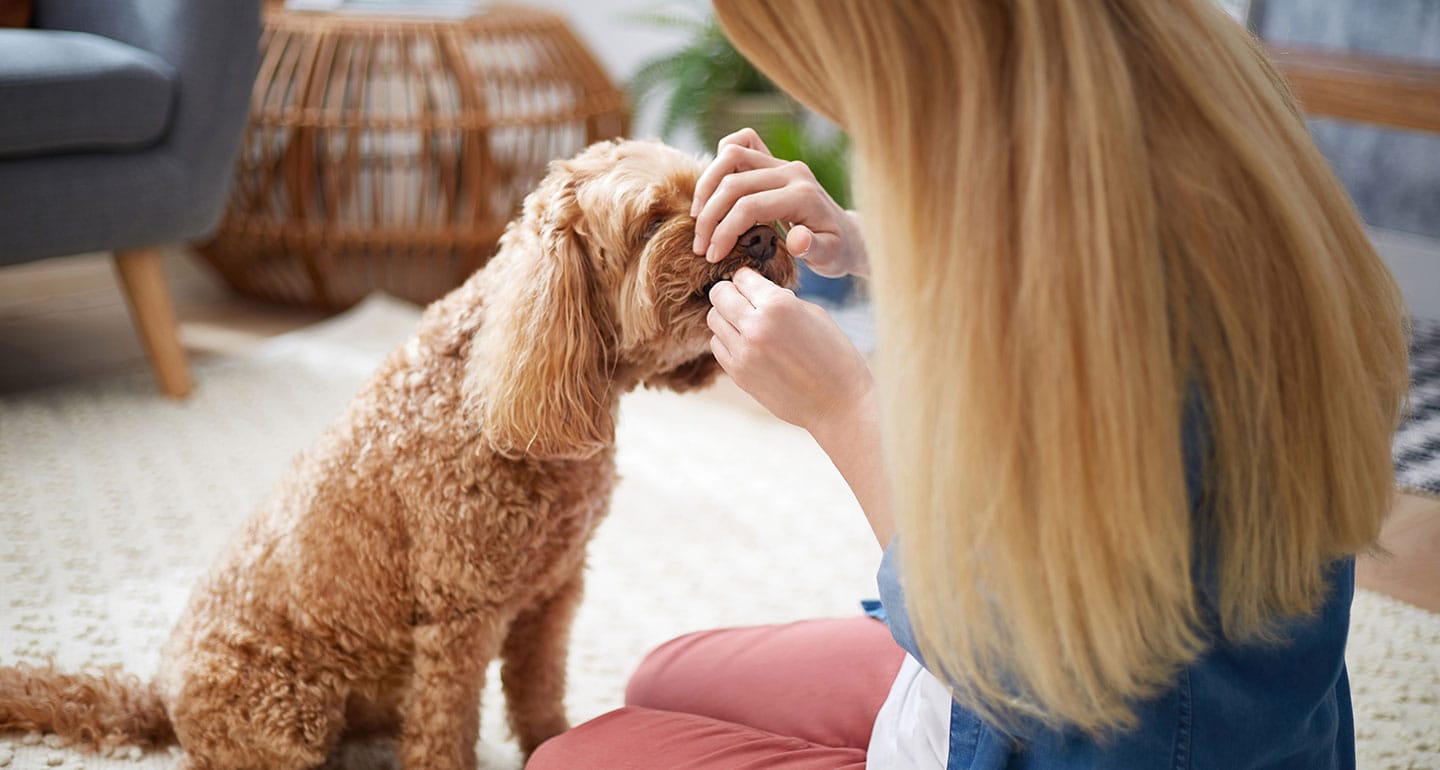
To begin, cup your hand under your dog’s chin.
- Hold it there for a few seconds.
- Then give them a treat from the other hand. This will probably feel like normal petting so it shouldn’t stress your dog out, says certified dog trainer Victoria Schade, CPDT-KA.
- Repeat the process several times so that your dog begins to associate your hands briefly under his muzzle with getting a treat.
Next, you want to get them used to having their lips lifted and their mouth opened.
- Place one hand under your dog’s muzzle and the other hand over the top for a few seconds.
- Then give them a treat.
- Continue by putting your hand in various positions on and around your dog’s mouth, trying to mimic what you’ll be doing when you actually start brushing, Schade says.
- Also practice approaching your dog from the side rather than the front, which will help them feel less intimidated, especially when you have a toothbrush in hand.
Lastly, mimic tooth brushing with your finger.
- Sitting on their left or right side, cup your dog’s muzzle in your hand while you lift their lip and examine their mouth with your fingers, Schade says.
- Then give them a treat.
- Practice running your finger along their gum line from the front all the way to the back where their molars are.
This whole getting-used-to-it stage could take anywhere from a week to several weeks—so be patient with your pal.
2Let your dog inspect the toothbrush and dog toothpaste.
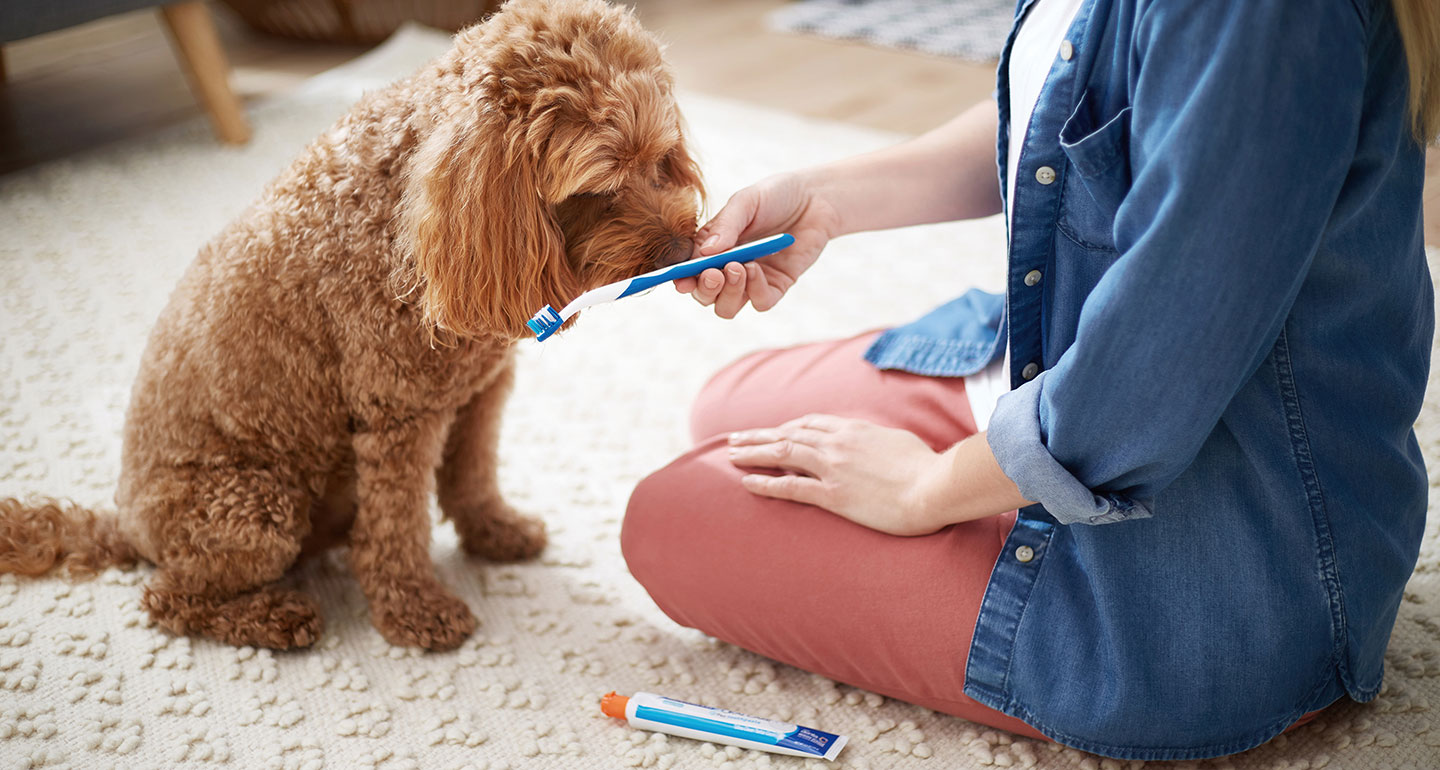
Once your dog is used to having their muzzle and mouth handled, it's time to bring in the dog toothbrushing supplies.
One of the biggest mistakes people make when using grooming tools is immediately jumping into the work without allowing the dog to examine the item first, says Schade.
When your dog is ready to move on to the next step, allow your dog to sniff and taste the toothbrush before you try to use it, again using lots of praise and positive reinforcement. Adding the toothpaste will make it even more interesting, which will work in your favor.
3Start brushing!
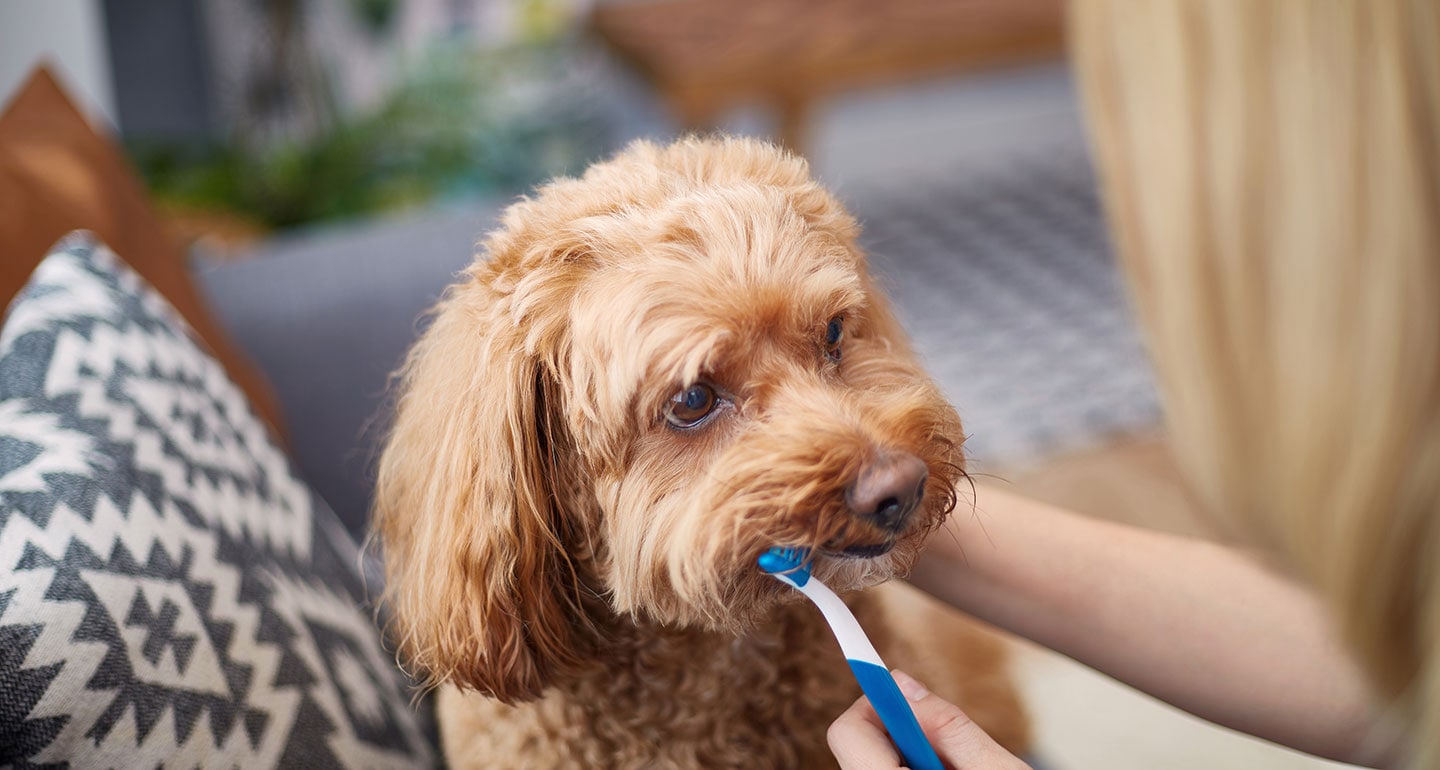
Find a comfortable spot to start your toothbrushing session.
Add a daub of the tasty toothpaste to your dog’s toothbrush bristles and begin by brushing your dog’s front teeth in a circular motion for a few seconds. Though you’ve done your prep work and your dog can tolerate the mouth handling, the addition of the toothbrush will make the process seem brand new again.
Pair the process with goodies to reassure your dog that good things happen when they allow you to work on their mouth, says Schade.
4Reward and repeat.
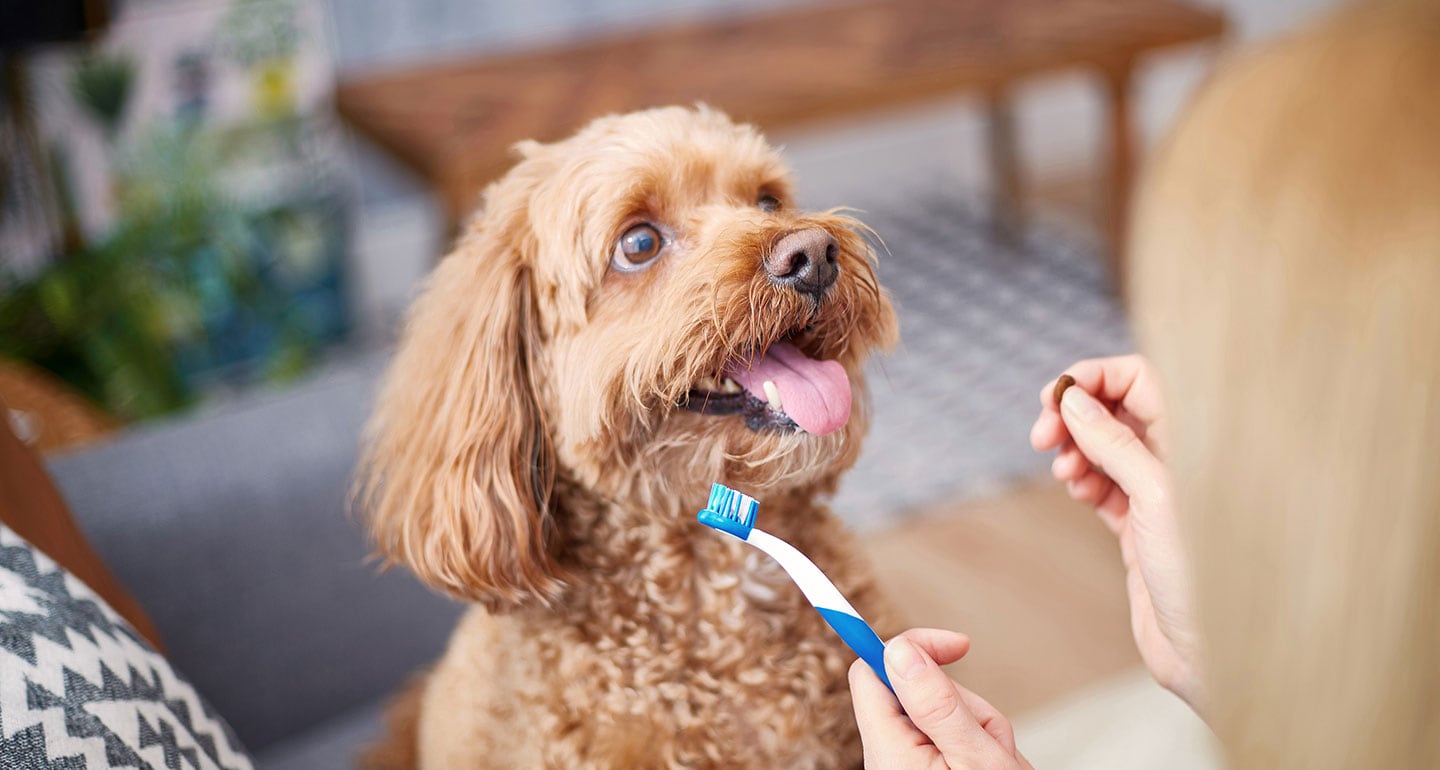
Don’t expect to complete your dog’s entire mouth the first time you brush.
Introduce the brush for about 10 seconds on your dog’s front teeth and then wrap it up for the day.
Continue these brief brushing sessions on the front and sides of your dog’s mouth over the course of a week, advises Schade. Your dog should accept the handling without complaint, and if you’ve done a good job with pairing the handling with treats, you dog might actually get excited when they see the toothbrush!
5Gradually work toward the back of your dog’s mouth, with the goal of brushing all their teeth—front to back—in one session.
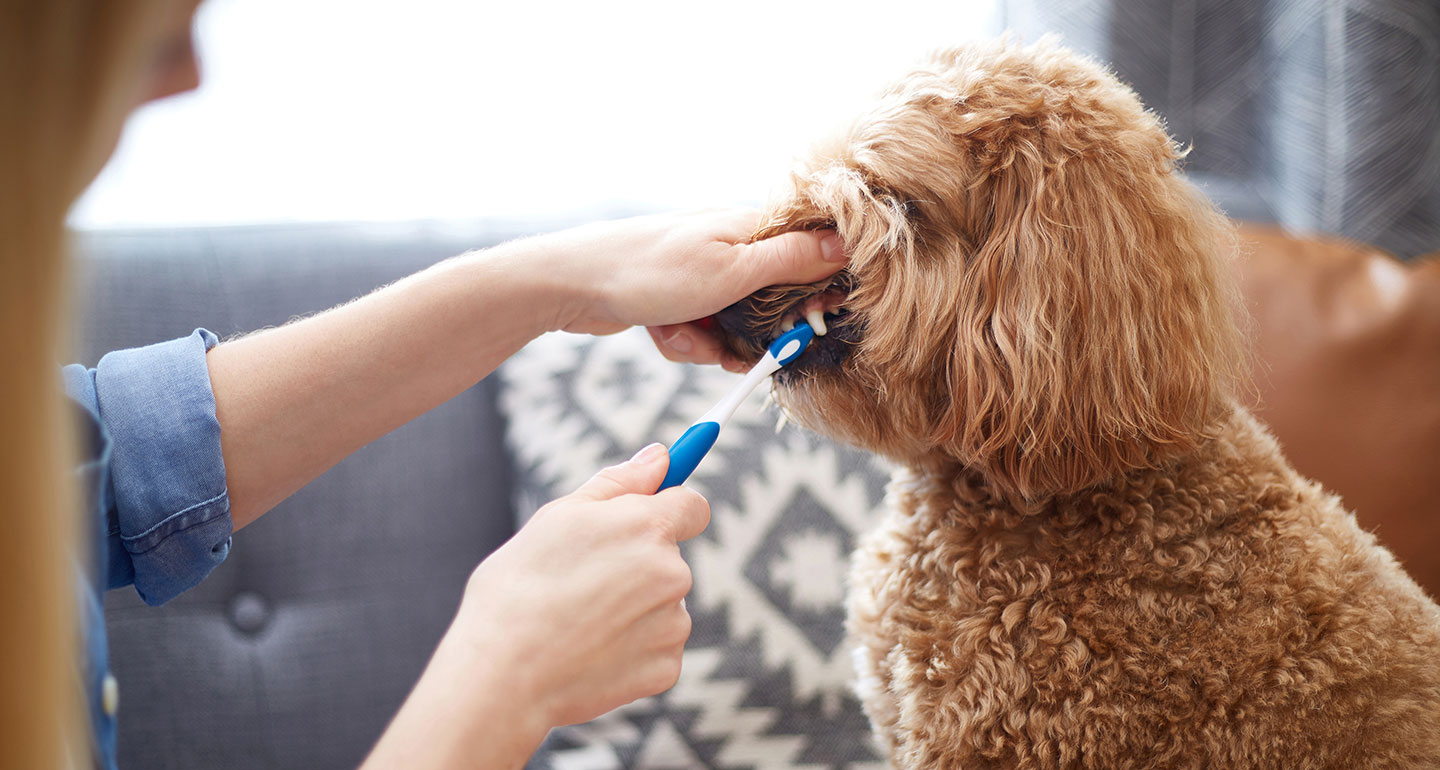
The process can be more challenging as you work toward the back of your dog’s mouth.
If you have a short-nosed breed, you might have to do some digging through lip and gums to find your dog’s molars. Rather than try to completely clean the back teeth in one attempt—keep in mind that this step requires holding your dog’s mouth open—try a several quick brushes so that the process remains comfortable for your dog, Schade says.
Toothbrushing can feel like a chore if you need to battle with your dog for access to their mouth, particularly when scrubbing those back molars. If your dog is comfortable with mouth handling but won’t stay still for some regular dental hygiene, enlist an assistance to help you.
How Often Do You Need to Brush a Dog’s Teeth?
When considering how often to brush dogs’ teeth, you should ideally give them a good dental cleaning every day, focusing on the outer part—or lip side—of the tooth surfaces.
“Daily brushing is best because plaque is easily brushed away,” Dr. Gaddis says. “It takes about 48 to 72 hours to harden and calcify and, therefore, need to be scraped off. The majority of plaque is on the outer surface so best to concentrate there, but some dogs will cooperate to open the mouth and brush the inner surfaces.”
How Long Should You Brush Your Dog’s Teeth?
The average toothbrushing session for dogs is the same as ours—about two minutes. (This might sound impossible, but it can be done with lots of patience and practice!) This duration, Dr. Kong explains, ensures that all the teeth, including those hard-to-reach back molars, are properly cleaned.
“Consistent, gentle brushing for this length of time can effectively remove plaque and prevent tartar buildup,” she says.
What’s more, brushing your dog’s teeth on a regular basis for this amount of time means healthy gums and teeth. It also reduces the likelihood of developing common dental conditions, like gingivitis, periodontal disease and tooth fractures.
When To Start Brushing Puppy Teeth
Both Dr. Kong and Dr. Alleyne recommend brushing a puppy’s teeth once they’re about 8-12 weeks old.
Dr. Alleyne says this allows for a puppy to get used to having a toothbrush in their mouth, which will increase their compliance during the process as they get older.
Regular brushing from a young age helps establish a good oral hygiene routine and can prevent dental problems—and other potential health problems—later in life, Dr. Kong says.
While the toothbrushing process might be tricky at first, your pup will become more accustomed to it with time and consistency. Plus, they’ll have excellent oral health as they grow older. Dental care is essential for a happy, healthy dog.
Do You Have To Brush Dog Teeth?
With a number of various ways to clean canine teeth, it’s only natural to wonder whether brushing your dog’s teeth is actually necessary.
The short answer: Yes!
“Regular toothbrushing is essential for dogs,” Dr. Kong says. “It helps prevent dental diseases, such as gingivitis, periodontitis and tooth decay. The benefits include better breath, healthier gums and the prevention of painful dental issues.”
Not brushing a dog’s teeth can lead to plaque and tartar buildup, oral infections and, in severe cases, the development of heart and kidney disease, she adds.
As with us, regularly brushing your dog’s teeth gets rid of plaque, eliminates bad breath and helps maintain not just their oral health but their overall health too.
How To Clean Dog Teeth Without Brushing
In between brushings, consider offering your pal some dental chews, like Greenies Dental Treats, American Journey Large Grain-Free Fresh Dental Dog Treats or Whimzees Dog Treats.
You could also add plaque-busting enzymes, like those found in ProDen PlaqueOff or VetriScience Perio Support, to their food.
Water additives can help fight plaque and tartar, too. Some trusted brands to consider include TropiClean’s Fresh Breath Water Additive, Oxyfresh’s Water Additive with Oxygene and Nylabone’s Advanced Oral Care Water Additive.
Just remember that none of these are intended to take the place of daily toothbrushing.
Dog Toothbrushing Tips and Troubleshooting
Through this entire process, your pal should remain calm and accepting as you work with them. If they react to any of the handling, Schade says, don’t push them. It’s likely you’ve moved too quickly through the process, so go back to the last type of handling that your dog accepted, and slowly work toward the next step.
Here are some other pro tips from trainer Schade:
-
Vary the length of time that you manipulate your dog’s muzzle and mouth, sometimes holding it for just a few seconds and others for a slightly longer period of time, and always follow each attempt with a treat. Work up to gently opening your dog’s mouth for a few moments.
-
Dip your finger in peanut butter before putting it in your dog’s mouth.
-
Don’t worry about “undoing” the brushing by using treats; dog toothpaste is formulated to dissolve long-term plaque buildup, so a few treats during the brushing won’t have any impact.
-
Some breeds have unique tooth growth patterns that cause the teeth to crowd together, so pay extra attention to those areas as they’re likely harbors for buildup.
-
Seek professional help for a dental examination and deep professional dental cleaning at least once per year, twice if your pal is prone to periodontal disease, advises Dr. Gaddis.
Good luck—and happy brushing!
Looking for the best dental chews for your pup? Check out this list of customer favorites.
More on keeping your dog's teeth clean:
Share:
